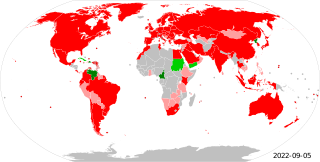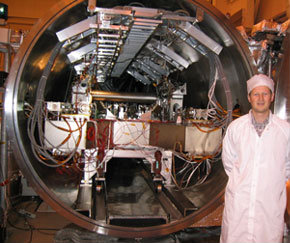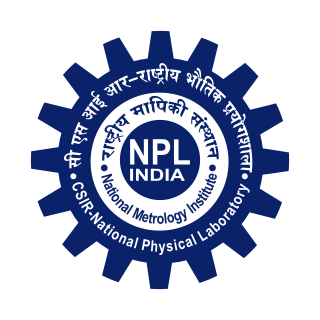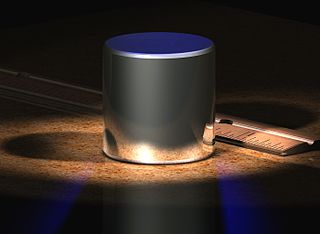
The Metre Convention, also known as the Treaty of the Metre, is an international treaty that was signed in Paris on 20 May 1875 by representatives of 17 nations. The treaty created the International Bureau of Weights and Measures (BIPM), an intergovernmental organization under the authority of the General Conference on Weights and Measures (CGPM) and the supervision of the International Committee for Weights and Measures (CIPM), that coordinates international metrology and the development of the metric system.
The National Institute of Standards and Technology (NIST) is a physical sciences laboratory and a non-regulatory agency of the United States Department of Commerce. Its mission is to promote innovation and industrial competitiveness. NIST's activities are organized into laboratory programs that include nanoscale science and technology, engineering, information technology, neutron research, material measurement, and physical measurement. From 1901–1988, the agency was named the National Bureau of Standards.

Laboratory glassware refers to a variety of equipment used in scientific work, and traditionally made of glass. Glass can be blown, bent, cut, molded, and formed into many sizes and shapes, and is therefore common in chemistry, biology, and analytical laboratories. Many laboratories have training programs to demonstrate how glassware is used and to alert first–time users to the safety hazards involved with using glassware.
In measurement technology and metrology, calibration is the comparison of measurement values delivered by a device under test with those of a calibration standard of known accuracy. Such a standard could be another measurement device of known accuracy, a device generating the quantity to be measured such as a voltage, a sound tone, or a physical artifact, such as a meter ruler.

Metrology is the scientific study of measurement. It establishes a common understanding of units, crucial in linking human activities. Modern metrology has its roots in the French Revolution's political motivation to standardise units in France, when a length standard taken from a natural source was proposed. This led to the creation of the decimal-based metric system in 1795, establishing a set of standards for other types of measurements. Several other countries adopted the metric system between 1795 and 1875; to ensure conformity between the countries, the Bureau International des Poids et Mesures (BIPM) was established by the Metre Convention. This has evolved into the International System of Units (SI) as a result of a resolution at the 11th Conference Generale des Poids et Mesures (CGPM) in 1960.

STS-66 was a Space Shuttle program mission that was flown by the Space Shuttle Atlantis. STS-66 launched on 3 November 1994 at 11:59:43.060 am EDT from Launch Pad 39-B at NASA's Kennedy Space Center. Atlantis landed at Edwards Air Force Base on 14 November 1994 at 10:33:45 am EST.

The CSIR- National Physical Laboratory of India, situated in New Delhi, is the measurement standards laboratory of India. It maintains standards of SI units in India and calibrates the national standards of weights and measures.
In metrology, measurement uncertainty is the expression of the statistical dispersion of the values attributed to a measured quantity. All measurements are subject to uncertainty and a measurement result is complete only when it is accompanied by a statement of the associated uncertainty, such as the standard deviation. By international agreement, this uncertainty has a probabilistic basis and reflects incomplete knowledge of the quantity value. It is a non-negative parameter.
The Institute for Reference Materials and Measurements (IRMM), located in Geel, Belgium, is one of the seven institutes of the Joint Research Centre (JRC), a Directorate-General of the European Commission (EC).
The International Federation of Clinical Chemistry and Laboratory Medicine or IFCC is a global organization that promotes the fields of clinical chemistry and laboratory medicine. It was established in 1952 as the International Association of Clinical Biochemists to organize the various national societies of these fields. The organization aims to transcend the boundaries of the field of clinical chemistry and laboratory medicine, to build professionalism of members worldwide, to disseminate information on ”best practice” at various levels of technology and of economic development, to provide a forum of standardization and traceability, to enhance the scientific level and the quality of diagnosis and therapy for patients.
The International Laboratory Accreditation Cooperation or ILAC started as a conference in 1977 with the aim of developing international cooperation for facilitating trade by promotion of the acceptance of accredited test and calibration results. In 1996, ILAC became a formal cooperation with a charter to establish a network of mutual recognition agreements among accreditation bodies that would fulfil this aim.
The Air Movement and Control Association International, Inc. (AMCA) is a long-established American trade body that sets standards for Heating, Ventilation and Air Conditioning (HVAC) equipment. It is best known for its ratings in fan balance and vibration, aerodynamic performance, air density, speed and efficiency.

Certified Reference Materials (CRMs) are ‘controls’ or standards used to check the quality and metrological traceability of products, to validate analytical measurement methods, or for the calibration of instruments. A certified reference material is a particular form of measurement standard.

The European Directorate for the Quality of Medicines & HealthCare (EDQM) is a Directorate of the Council of Europe that traces its origins and statutes to the Convention on the Elaboration of a European Pharmacopoeia.
Forensic metrology is metrology, the science of measurement, as it applies to forensic sciences. Forensic laboratories and criminalistic laboratories perform numerous measurements and tests to support both criminal and civil legal actions. Examples of forensic metrology include the measurement of blood or breath alcohol content, the quantification of controlled substances, and length measurements of firearm barrels. The results of forensic measurements are used to determine if a person is charged with a crime or may be used to determine a statutory sentencing enhancement. Other examples of forensic metrology includes tests that measure if there is a presence of a substance, latent print examination, questioned documents examination, and DNA analysis.

In metrology, a standard is an object, system, or experiment that bears a defined relationship to a unit of measurement of a physical quantity. Standards are the fundamental reference for a system of weights and measures, against which all other measuring devices are compared. Historical standards for length, volume, and mass were defined by many different authorities, which resulted in confusion and inaccuracy of measurements. Modern measurements are defined in relationship to internationally standardized reference objects, which are used under carefully controlled laboratory conditions to define the units of length, mass, electrical potential, and other physical quantities.

The International Measurement Confederation is a non-governmental federation of metrological organizations. It was founded in 1958 in Budapest, Hungary.
The Joint Committee for Guides in Metrology (JCGM), is an organization in Sèvres that prepared the "Guide to the expression of uncertainty in measurement" (GUM) and the "International vocabulary of metrology – basic and general concepts and associated terms" (VIM). The JCGM assumed responsibility for these two documents from the ISO Technical Advisory Group 4 (TAG4).
The National Standardization Body of Indonesia is the International Organization for Standardization (ISO) member body for Indonesia. BadanStandardisasiNasional is a non-ministerial Indonesian government agency with the main task of carrying out governmental tasks in the field of standardization and conformity assessment in Indonesia.
NPU terminology is a patient centered clinical laboratory terminology for use in the clinical laboratory sciences. Its function is to enable results of clinical laboratory examinations to be used safely across technology, time and geography. To achieve this, the NPU terminology supplies:








